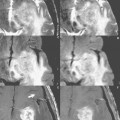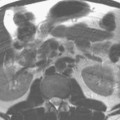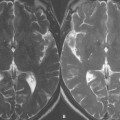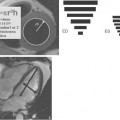102 Flow Artifacts
A T1-weighted axial gradient echo scan of the abdomen is illustrated in Fig. 102.1A. The addition of spatial saturation pulses, above and below the level of the slice, leads to loss of flow-related enhancement within the major blood vessels (Fig. 102.1B). Prominent ghosts are noted from the inferior vena cava and aorta in the phase-encoding direction on an axial T1-weighted fast spin echo image (Fig. 102.1C). Placement of a saturation pulse above the slice eliminates the ghosts from the aorta but not the cava (Fig. 102.1D, arrow), whereas a saturation pulse placed below the slice eliminates the ghosts from the cava but not the aorta (Fig. 102.1E, arrow). Using saturation pulses both above and below the slice largely eliminates these vascular ghosts (Fig. 102.1F). Saturation pulses cause the signal of in-flowing blood to be markedly reduced. The ghosts from blood vessels are caused by phase dispersion, and the less the signal (due to the use of the saturation pulses), the less the ghosts.
Stay updated, free articles. Join our Telegram channel

Full access? Get Clinical Tree








